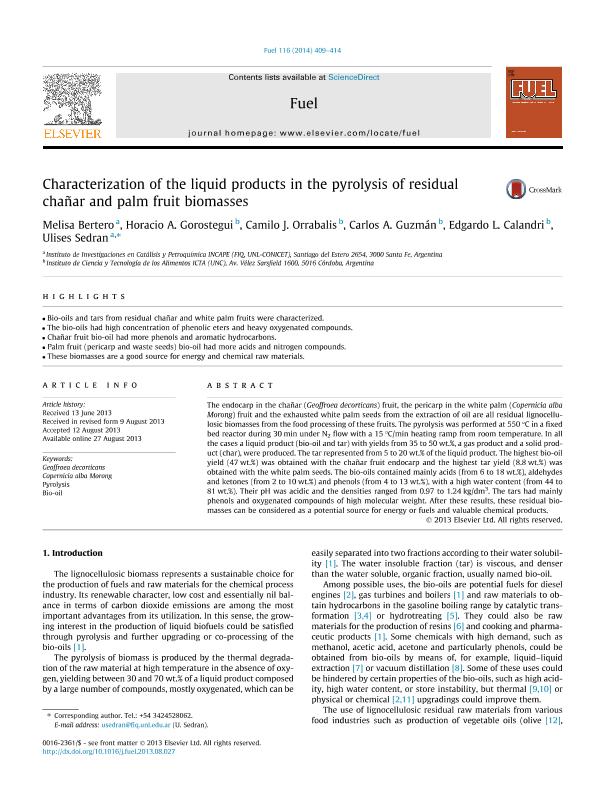Artículo
Characterization of the liquid products in the pyrolysis of residual chañar and palm fruit biomasses
Bertero, Melisa Paola ; Gorostegui, Horacio Adrián; Orrabalis, Camilo Javier; Guzman, Carlos Alberto
; Gorostegui, Horacio Adrián; Orrabalis, Camilo Javier; Guzman, Carlos Alberto ; Calandri, Edgardo Luis; Sedran, Ulises Anselmo
; Calandri, Edgardo Luis; Sedran, Ulises Anselmo
 ; Gorostegui, Horacio Adrián; Orrabalis, Camilo Javier; Guzman, Carlos Alberto
; Gorostegui, Horacio Adrián; Orrabalis, Camilo Javier; Guzman, Carlos Alberto ; Calandri, Edgardo Luis; Sedran, Ulises Anselmo
; Calandri, Edgardo Luis; Sedran, Ulises Anselmo
Fecha de publicación:
01/2014
Editorial:
Elsevier
Revista:
Fuel
ISSN:
0016-2361
Idioma:
Inglés
Tipo de recurso:
Artículo publicado
Clasificación temática:
Resumen
The endocarp in the chañar (Geoffroea decorticans) fruit, the pericarp in the white palm (Copernicia alba Morong) fruit and the exhausted white palm seeds from the extraction of oil are all residual lignocellulosic biomasses from the food processing of these fruits. The pyrolysis was performed at 550 C in a fixed bed reactor during 30 min under N2 flow with a 15 C/min heating ramp from room temperature. In all the cases a liquid product (bio-oil and tar) with yields from 35 to 50 wt.%, a gas product and a solid product (char), were produced. The tar represented from 5 to 20 wt.% of the liquid product. The highest bio-oil yield (47 wt.%) was obtained with the chañar fruit endocarp and the highest tar yield (8.8 wt.%) was obtained with the white palm seeds. The bio-oils contained mainly acids (from 6 to 18 wt.%), aldehydes and ketones (from 2 to 10 wt.%) and phenols (from 4 to 13 wt.%), with a high water content (from 44 to 81 wt.%). Their pH was acidic and the densities ranged from 0.97 to 1.24 kg/dm3. The tars had mainly phenols and oxygenated compounds of high molecular weight. After these results, these residual biomasses can be considered as a potential source for energy or fuels and valuable chemical products.
Palabras clave:
Geoffroea Decorticans
,
Copernicia Alba Morong
,
Pyrolysis
,
Bio-Oil
Archivos asociados
Licencia
Identificadores
Colecciones
Articulos(INCAPE)
Articulos de INST.DE INVEST.EN CATALISIS Y PETROQUIMICA "ING. JOSE MIGUEL PARERA"
Articulos de INST.DE INVEST.EN CATALISIS Y PETROQUIMICA "ING. JOSE MIGUEL PARERA"
Citación
Bertero, Melisa Paola; Gorostegui, Horacio Adrián; Orrabalis, Camilo Javier; Guzman, Carlos Alberto; Calandri, Edgardo Luis; et al.; Characterization of the liquid products in the pyrolysis of residual chañar and palm fruit biomasses; Elsevier; Fuel; 116; 1-2014; 409-414
Compartir
Altmétricas



